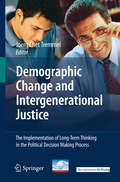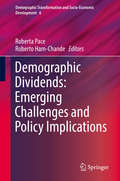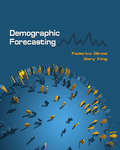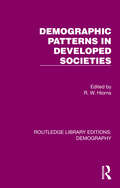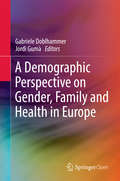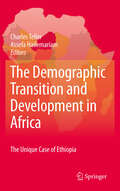- Table View
- List View
Demographic Change and Intergenerational Justice: The Implementation of Long-Term Thinking in the Political Decision Making Process
by Joerg TremmelIntergenerational justice has been achieved if the opportunities of the members of the next generation to fulfill their needs are better than those of the members of the preceding generation. For this, each generation ought to leave for the next generation an amount of resources is at least equal to its own amount. The book deals with the complex relationship between intergenerational justice and demographic change and is characterized by its interdisciplinary approach. The authors come from a multitude of professional backgrounds and from several countries. This illustrates the implications of the demographic shift from many different perspectives. The book deals not only with the aspects of economic policy but also with environmental, societal and philosophical issues. The comprehensive volume is composed of five sections that pinpoint demographic trends, examine the impact of demographic changes on key indicators, investigate the relationship between key indicators and intergenerational justice, scrutinize population policies, and finally propose ways to implement long-term thinking on these issues.
Demographic Change in Germany: The Economic and Fiscal Consequences
by Ingrid Hamm Helmut Seitz Martin WerdingThis book provides an up-to-date summary of the consequences of demographic aging for labor markets, financial markets, economic growth, social security schemes and public finances in Germany, essentially reflecting the present state of knowledge in any of these areas. All contributions are written by leading experts in their fields and are based on results that emerge at the forefront of current research.
Demographic Developments in China (Routledge Studies on the Chinese Economy)
by China Development Research FoundationThis book assesses current developments in China’s demography, and discusses the changes which should be implemented to bring policy into line with the current demographic situation. It argues that population planning, which was introduced in the early years of the People’s Republic alongside economic planning, including "the one child policy", is no longer appropriate. It considers the results of the 2010 census, which showed the very significant shifts that are occurring , including a declining rate of population growth, ongoing growth of the number of people in "the floating population", an increasingly imbalanced sex ratio among newborn children, and ongoing ageing of the population. Besides discussing population planning policy, the book also examines how policies in the fields of education, health, gender relations, child development in rural areas, and polices for the elderly and families should be adjusted to accommodate demographic developments.
Demographic Developments in China (Routledge Studies on the Chinese Economy)
by China Development Research FoundationThis book assesses current developments in China’s demography, and discusses the changes which should be implemented to bring policy into line with the current demographic situation. It argues that population planning, which was introduced in the early years of the People’s Republic alongside economic planning, including "the one child policy", is no longer appropriate. It considers the results of the 2010 census, which showed the very significant shifts that are occurring , including a declining rate of population growth, ongoing growth of the number of people in "the floating population", an increasingly imbalanced sex ratio among newborn children, and ongoing ageing of the population. Besides discussing population planning policy, the book also examines how policies in the fields of education, health, gender relations, child development in rural areas, and polices for the elderly and families should be adjusted to accommodate demographic developments.
Demographic Dividends: Emerging Challenges and Policy Implications (Demographic Transformation and Socio-Economic Development #6)
by Roberta Pace Roberto Ham-ChandeThis book examines potential economic opportunities that countries can experience when fertility rates fall and the average life expectancy of the working age population increases. It presents detailed demographic and economic analysis of middle-income countries throughout the world in order to show how these countries can take advantage of this demographic bonus. The book first traces the common link between policies that contribute to fertility transition as well as create the right kind of environment for reaping the benefit of demographic dividend. Next, it explores different countries and regions who are at different levels of development. It assesses the long term impact of gender equality on economic growth and development in Latin America; describes the life-cycle saving patterns of Mexican households; and examines demographic determinants of economic growth in BRICS. The book also offers demographic and economic analysis of the Mediterranean area, Sub-Saharan Africa, and New Zealand. The comparison between the different territorial contexts allow for the identification of three typologies of demographic dividend: the first dividend, when the working population grows faster than total population, the second dividend, as active generations get older and invest their savings in the production system of their country, and the third dividend, based on the coexistence of two populations age structure strongly contrasting. Overall, this book argues for the need to capitalize on the opportunities that come from the demographic dividend by investing heavily in education programs, training programs for the population working age, health programs, the creation of health insurance systems as well as programs to reduce or increase fertility levels.
Demographic Dynamics and Development
by Yves CharbitOne of the major challenges facing the world today is the interaction between demographic change and development. Demographic Dynamics and Development reviews the dominant demographic theory, demographic transition, and then presents a thorough investigation covering aging, fertility, contraception, nuptiality, mortality and migration, which are all aspects that drive these changes. Each chapter combines the latest empirical data with theoretical reflections on the implications for development.This book thus offers an overview of worldwide demographic data, studied with a view towards development. In doing so, it provides researchers and specialists with clear information through in-depth case studies, focusing on a country, a region or a particularly important scientific sub-theme.
Demographic Dynamics and Development
by Yves CharbitOne of the major challenges facing the world today is the interaction between demographic change and development. Demographic Dynamics and Development reviews the dominant demographic theory, demographic transition, and then presents a thorough investigation covering aging, fertility, contraception, nuptiality, mortality and migration, which are all aspects that drive these changes. Each chapter combines the latest empirical data with theoretical reflections on the implications for development.This book thus offers an overview of worldwide demographic data, studied with a view towards development. In doing so, it provides researchers and specialists with clear information through in-depth case studies, focusing on a country, a region or a particularly important scientific sub-theme.
Demographic Engineering: Population Strategies In Ethnic Conflict (International Population Studies)
by Paul MorlandDemography has always mattered in conflict, but with conflict increasingly of an inter-ethnic nature, with sharper demographic differences between ethnic groups and with the spread of democracy, numbers count in conflict now more than ever. This book argues for and develops a framework for demographic engineering which provides a fresh perspective for looking at political events in countries where ethnicity matters. It asks how policies have been framed and implemented to change the demography of ethnic groups on the ground in their own interests. It also examines how successful these policies have been, focusing on the cases of Sri Lanka, Israel/Palestine, Northern Ireland and the USA. Often these policies are hidden but author Paul Morland teases them out with skill both from the statistics and documentary records and through conversations with participants. Offering a new way of thinking about demographic engineering (’hard demography’ versus ’soft demography’) and how ethnic groups in conflict deploy demographic strategies, this book will have a broad appeal to demographers, geographers and political scientists.
Demographic Engineering: Population Strategies in Ethnic Conflict
by Paul MorlandDemography has always mattered in conflict, but with conflict increasingly of an inter-ethnic nature, with sharper demographic differences between ethnic groups and with the spread of democracy, numbers count in conflict now more than ever. This book argues for and develops a framework for demographic engineering which provides a fresh perspective for looking at political events in countries where ethnicity matters. It asks how policies have been framed and implemented to change the demography of ethnic groups on the ground in their own interests. It also examines how successful these policies have been, focusing on the cases of Sri Lanka, Israel/Palestine, Northern Ireland and the USA. Often these policies are hidden but author Paul Morland teases them out with skill both from the statistics and documentary records and through conversations with participants. Offering a new way of thinking about demographic engineering (’hard demography’ versus ’soft demography’) and how ethnic groups in conflict deploy demographic strategies, this book will have a broad appeal to demographers, geographers and political scientists.
Demographic Forecasting (PDF)
by Federico Girosi Gary KingDemographic Forecasting introduces new statistical tools that can greatly improve forecasts of population death rates. Mortality forecasting is used in a wide variety of academic fields, and for policymaking in global health, social security and retirement planning, and other areas. Federico Girosi and Gary King provide an innovative framework for forecasting age-sex-country-cause-specific variables that makes it possible to incorporate more information than standard approaches. These new methods more generally make it possible to include different explanatory variables in a time-series regression for each cross section while still borrowing strength from one regression to improve the estimation of all. The authors show that many existing Bayesian models with explanatory variables use prior densities that incorrectly formalize prior knowledge, and they show how to avoid these problems. They also explain how to incorporate a great deal of demographic knowledge into models with many fewer adjustable parameters than classic Bayesian approaches, and develop models with Bayesian priors in the presence of partial prior ignorance. By showing how to include more information in statistical models, Demographic Forecasting carries broad statistical implications for social scientists, statisticians, demographers, public-health experts, policymakers, and industry analysts. Introduces methods to improve forecasts of mortality rates and similar variables Provides innovative tools for more effective statistical modeling Makes available free open-source software and replication data Includes full-color graphics, a complete glossary of symbols, a self-contained math refresher, and more
Demographic Forecasting (PDF)
by Federico Girosi Gary KingDemographic Forecasting introduces new statistical tools that can greatly improve forecasts of population death rates. Mortality forecasting is used in a wide variety of academic fields, and for policymaking in global health, social security and retirement planning, and other areas. Federico Girosi and Gary King provide an innovative framework for forecasting age-sex-country-cause-specific variables that makes it possible to incorporate more information than standard approaches. These new methods more generally make it possible to include different explanatory variables in a time-series regression for each cross section while still borrowing strength from one regression to improve the estimation of all. The authors show that many existing Bayesian models with explanatory variables use prior densities that incorrectly formalize prior knowledge, and they show how to avoid these problems. They also explain how to incorporate a great deal of demographic knowledge into models with many fewer adjustable parameters than classic Bayesian approaches, and develop models with Bayesian priors in the presence of partial prior ignorance. By showing how to include more information in statistical models, Demographic Forecasting carries broad statistical implications for social scientists, statisticians, demographers, public-health experts, policymakers, and industry analysts. Introduces methods to improve forecasts of mortality rates and similar variables Provides innovative tools for more effective statistical modeling Makes available free open-source software and replication data Includes full-color graphics, a complete glossary of symbols, a self-contained math refresher, and more
The Demographic Masculinization of China: Hoping for a Son (INED Population Studies #1)
by Isabelle AttanéThis book describes the shortage of girls and women in present day China and focuses on two important features: the sex imbalance in childhood and youth, and the excess mortality of women at various stages of their life. The author analyzes the causes and the processes of a strong preference for sons, which generates discrimination toward females and results in a shortage of girls and women. China’s higher proportion of men than women is a population characteristic that is shared by very few countries in the world. This demographic masculinity is unprecedented in the documented history of human populations, both in scale and its lasting impact on the numbers and the structure of the population. Despite the economic boom of recent years, many families in China still consider girls to be less important than boys. Although Chinese women have become largely emancipated since the 1950s, they still do not have the same opportunities for social achievement as men, and Chinese society remains fundamentally rooted in highly gendered social and family roles. As a consequence, Chinese girl babies who have the misfortune to be born instead of a long-awaited son go by various names, such as Pandi (literally "awaiting a son"), Laidi ("a son will follow"), or Yehao ("she'll do too"). The book provides a comprehensive review of the situation of women in China’s society and shows that discrimination against girls and women is part of a system of norms and values that traditionally favours males.
Demographic Methods
by Andrew HindeFirst published in 1998. Routledge is an imprint of Taylor & Francis, an informa company.
Demographic Methods
by Andrew HindeFirst published in 1998. Routledge is an imprint of Taylor & Francis, an informa company.
Demographic Patterns in Developed Societies (Routledge Library Editions: Demography #7)
by R. W. HiornsOriginally published in 1980, this volume reviews the demographic patterns of fertility, marriage and mortality with reference to developed societies in the 19th and 20th centuries in Western Europe and North America. New (at the time of publication) data and methodology are considered and discussed, while maintaining the historical perspective.
Demographic Patterns in Developed Societies (Routledge Library Editions: Demography #7)
Originally published in 1980, this volume reviews the demographic patterns of fertility, marriage and mortality with reference to developed societies in the 19th and 20th centuries in Western Europe and North America. New (at the time of publication) data and methodology are considered and discussed, while maintaining the historical perspective.
A Demographic Perspective on Gender, Family and Health in Europe
by Gabriele Doblhammer Jordi GumàThis open access book examines the triangle between family, gender, and health in Europe from a demographic perspective. It helps to understand patterns and trends in each of the three components separately, as well as their interdependencies. It overcomes the widely observable specialization in demographic research, which usually involves researchers studying either family or fertility processes or focusing on health and mortality. Coverage looks at new family and partnership forms among the young and middle-aged, their relationship with health, and the pathways through which they act. Among the old, lifelong family biography and present family situation are explored. Evidence is provided that partners advancing in age start to resemble each other more closely in terms of health, with the health of the partner being a crucial factor of an individual’s own health. Gender-specific health outcomes and pathways are central in the designs of the studies and the discussion of the results. The book compares twelve European countries reflecting different welfare state regimes and offers country-specific studies conducted in Austria, Germany, Italy - all populations which have received less attention in the past - and Sweden. As a result, readers discover the role of different concepts of family and health as well as comparisons within European countries and ethnic groups. It will be an insightful resource for students, academics, policy makers, and researchers that will help define future research in terms of gender and public health.
Demographic Processes, Occupation and Technological Change: Symposium held at the University of Bamberg from 17th to 18th November 1989
by Ulrich Blum Josef SchmidDemographic Responses To Development: Sources Of Declining Fertility In The Philippines
by Robert A HackenbergThis study examines the causes of declining fertility in a major Southeast Asian nation, the Philippines. Although others maintain that increased use of family planning is the source of reduced reproductive rates throughout the region, the authors show that the reduction in birth rate in the 1970s was much greater than the drop in fertility among m
Demographic Responses To Development: Sources Of Declining Fertility In The Philippines
by Robert A HackenbergThis study examines the causes of declining fertility in a major Southeast Asian nation, the Philippines. Although others maintain that increased use of family planning is the source of reduced reproductive rates throughout the region, the authors show that the reduction in birth rate in the 1970s was much greater than the drop in fertility among m
A Demographic Study of an Egyptian Province (Sharquiya)
by A. M. AmmarInitially published in 1943. In A Demographic Study of an Egyptian Province (Sharquiya) Dr Ammar, an Egyptian anthropologist, raises a number of questions around the relevance of and need for accurate population statistics in field economic studies. His tables and sociological analysis will be of particular interest to those working in other Muslim areas and the economic conclusions he draws, have familiarity to all who are studying 'the problem of primary poverty'.
A Demographic Study of an Egyptian Province (Sharquiya)
by A. M. AmmarInitially published in 1943. In A Demographic Study of an Egyptian Province (Sharquiya) Dr Ammar, an Egyptian anthropologist, raises a number of questions around the relevance of and need for accurate population statistics in field economic studies. His tables and sociological analysis will be of particular interest to those working in other Muslim areas and the economic conclusions he draws, have familiarity to all who are studying 'the problem of primary poverty'.
Demographic Targeting: The Essential Role of Population Groups in Retail Marketing (Routledge Revivals)
by James A. PoolerThis title was first published in 2002: Retailers who ignore the demographics of their customers do so at their peril. Examining the role of age and gender in the behavior and patterns of shoppers, this book looks at all shoppers as members of distinct demographic groups, each of which marches to the beat of its own drum. We can say a lot about people and their shopping behavior simply by examining their demographic group membership. For example, we can say that middle-aged shoppers have less time available for shopping, but more money. Such ideas provide valuable information about how to sell to them. Demographic targeting is the key to success when it comes to modern retailing. This book takes a look at shopping from the perspective of demography and considers the demographic group to be a crucial concept for understanding the modern shopper.
Demographic Targeting: The Essential Role of Population Groups in Retail Marketing (Routledge Revivals)
by James A. PoolerThis title was first published in 2002: Retailers who ignore the demographics of their customers do so at their peril. Examining the role of age and gender in the behavior and patterns of shoppers, this book looks at all shoppers as members of distinct demographic groups, each of which marches to the beat of its own drum. We can say a lot about people and their shopping behavior simply by examining their demographic group membership. For example, we can say that middle-aged shoppers have less time available for shopping, but more money. Such ideas provide valuable information about how to sell to them. Demographic targeting is the key to success when it comes to modern retailing. This book takes a look at shopping from the perspective of demography and considers the demographic group to be a crucial concept for understanding the modern shopper.
The Demographic Transition and Development in Africa: The Unique Case of Ethiopia
by Charles Teller"The heated Malthusian-Bosrupian debates still rage over consequences of high population growth, rapid urbanization, dense rural populations and young age structures in the face of drought, poverty, food insecurity, environmental degradation, climate change, instability and the global economic crisis. However, while facile generalizations about the lack of demographic change and lack of progress in meeting the MDGs in sub-Saharan Africa are commonplace, they are often misleading and belie the socio-cultural change that is occurring among a vanguard of more educated youth. Even within Ethiopia, the second largest country at the Crossroads of Africa and the Middle East, different narratives emerge from analysis of longitudinal, micro-level analysis as to how demographic change and responses are occurring, some more rapidly than others. The book compares Ethiopia with other Africa countries, and demonstrates the uniqueness of an African-type demographic transition: a combination of poverty-related negative factors (unemployment, disease, food insecurity) along with positive education, health and higher age-of-marriage trends that are pushing this ruggedly rural and land-locked population to accelerate the demographic transition and stay on track to meet most of the MDGs. This book takes great care with the challenges of inadequate data and weak analytical capacity to research this incipient transition, trying to unravel some of the complexities in this vulnerable Horn of Africa country: A slowly declining population growth rates with rapidly declining child mortality, very high chronic under-nutrition, already low urban fertility but still very high rural fertility; and high population-resource pressure along with rapidly growing small urban places”
